SIGN: The
American Sign Language (ASL) sign for "sign
/ signing / sign language"
If you mean "sign" sign as in a "display" or a "road sign" see "SIGN-[square
/ display]
There is more than one common sign for "SIGN" (as in "signing or sign
language.")
SIGN: "a sign," "sign this," "signed," "signing," "sign language," "signs":



This version of "sign" is done using a quick open and close movement.
SIGNING-[advanced-signing, ASL-type-signing, skilled signing]

Sentence: Who in your family signs?
Gloss: YOUR FAMILY SIGN, WHO?
A common sign for "sign /
signing / sign language" that has been around for a long is done using your
index fingers.
Form both hands into "1" hand shapes. Then draw a couple of large circles
in the air with the tip of each index finger. You can either circle the
hands backwards or forwards (but pick a direction and stick with it). The
hands both move at the same time but one hand is half a circle ahead of the
other hand).
I personally tend to do the movement as if pedaling a (stationary) bicycle
backwards. Both hands move at the same time. When the right hand is up,
the left hand is down. When the right hand is forward, the left hand is
back. However some signers prefer to "pedal" using a forward rotation.
At the time of this writing, one version is not more right than the other (but
some people will try to tell you their version is right).
SIGN-[a sign,
signing-(basic), sign language-(general)]
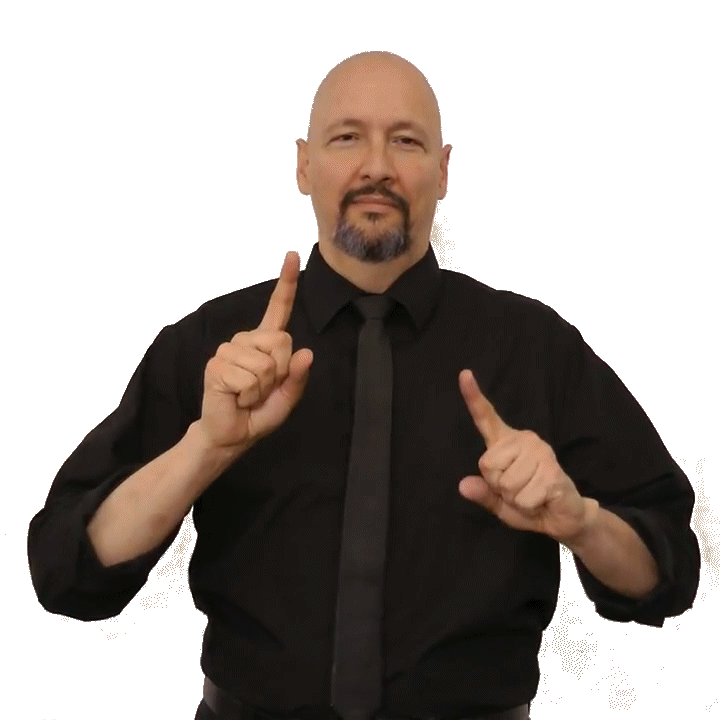
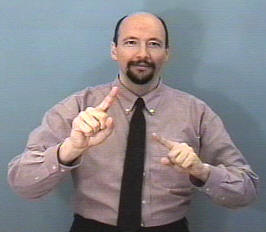
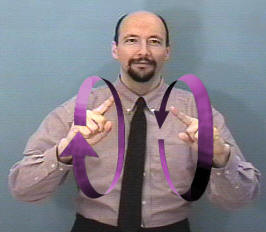
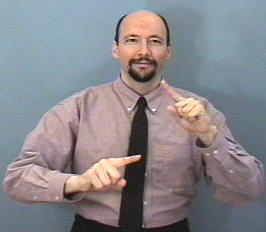
Click this link to see a "gif" animation of this sign: "Sign Language"
(.gif file)
Remember, many people do the sign with a forward, down, back, up movement --
as if pedaling a bicycle forwards.)
Note:
The sign for "sign" as in "a roadway sign" or a billboard is different from
"sign" as in "American Sign Language."
If you want to talk about a road sign, billboard, blackboard, or square, see:
SQUARE
Optional Reading (Not required)
Student: For "SIGN," should the fingers be moving in towards the body
at the top of the circle, or at the bottom of the circle?
Dr. Bill: Would you believe
"either?" It is done both ways in the Deaf Community. I
do it with the fingers moving in toward the body at the top of the circle.
But lots of people do it the other way too. Out of curiosity, I just looked
in a couple of the ASL dictionaries I have sitting here on my shelf and sure
enough one shows the fingers moving back, the other shows them moving
forward.
In a message dated 10/25/2005 4:24:51 P.M. Pacific Daylight Time, january_june@___com writes:
I can't seem to have each hand circling in different directions. My question is, is this a common mistake? Also, does it mean something completely different? In other words, if I signed 'sign' with my fingers both making circles in the same direction, would I end up offending someone or telling them I'm pregnant? Clumsy mistakes are no fun :P
-Brittany
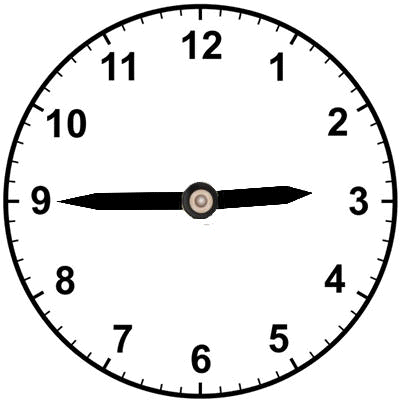 Brittany,
Brittany,
Your hands should not
"circle" in two different directions. They actually circle in the
same direction -- just one hand is further along in the circle than the
other. Think of two race cars on the same track. One car is
half a lap in front of the other. They are going the same circular
direction. Compare this situation to the hands on an analog clock.
Suppose it were 2:45 p.m., the clock would look like this:
Oh sure, I understand "why" it is confusing. In the clock example
the long-hand has an upward movement while the short-hand has a downward
movement. From that perspective it sounds like they are moving in
different directions and they are in the sense that one is going up
and one is going down - but when viewed from a larger perspective, the
hands of the clock are moving in the same direction:
clockwise. The same is true of the movement of your hands in this
sign. They both rotate in the same direction but they are on
opposite sides of the circle.
- Dr. Bill
In a message dated 7/7/2007 4:47:33 A.M. Mountain Daylight Time, lwilt@ writes:
Hi, Dr. Bill,
I haven't asked you a question in a long time, but have one now...What is the difference (in usage) between the sign for sign: as in sign language
- one is the index fingers going around each other
- and the other is "s" hands throwing forward into relaxed "c" or "5" hands?
Thanks, Bill, hope all is well with you!
Linda Wilt
Easton, Md
Hi Linda,
The "index finger version means "signing in general."
The "S" hand version refers to the "skilled use of ASL"
(not "contact signing" nor Signed English").
Both signs can be further modified (by changes in movement, path, speed,
orientation, facial expression, and posture) to indicate signing of
various styles and skill levels.
-- Dr. Bill
[Edit: 13 years later
-- in 2020 -- the "throwing S's" version of "sign" now also means
signing in general too and we just do the sign faster and/or with more
facial expression to indicate "skilled" signing]
Question: A student asks:
"I was wondering if the 2 versions of SIGN are technically supposed to
be used in different contexts or if they can basically be used
interchangeably? I took an ASL 1 course one semester about 4 years ago
but was unable to continue on with the courses and only remember ever
learning about the version where you use both pointer fingers and form
circles but that could just be because they go over the other sign in
another class."
- (Student's name removed for privacy.)
Response:
ASL, like all living languages, changes over time.
The sign for "sign / signing / signed / sign language" -- is changing
and adapting currently -- right now Answers to this same question a few
years ago are not the answer I'd give now.
Any answer I or someone else gives you now will likely be different a
few years from now.
Both versions of the sign for "sign" can be modified (by changes in
movement, path, speed, orientation, facial expression, and posture) to
indicate signing of various styles and skill levels.
The most recent adaptation of the sign for "signing" that I've seen (as
of this comment) is to do a one-handed S-5-S using a small "throw" and
retract movement. (I'll be adding that version to my online ASL
dictionary eventually.)
The fact is though you will still see "both" versions of the sign for
"sign" -- and various applications of the signs for "sign" out in the
real world because not all Deaf sign the same and not all Deaf decide at
the same time to accept and use new versions of signs.
If someone in your social circle or a teacher "insists" that you should
sign something a certain way -- sure, go ahead and make them happy. Then
actually invest a significant amount of your own time watching videos of
a variety of Deaf signers and form your own opinion based on a wide
sample.
See:
https://www.lifeprint.com/asl101/pages-layout/teachingasl/teachingasl-bill.htm
Notes:
Also see: STUDENT
Neologism: Advanced one-handed version of:
SIGN-[sign-something-in-fluent-ASL, do-a-sign, sign-language]

The one-handed "S-Claw-S" version of "SIGN" can be seen in conversations in which one of the signers chooses to sign one handed (for example -- due to holding a phone during a video call).
Notes:
Question: Samantha ██████ commented / asked:
Ok, I'm sure you're sick of my name popping up, but you have been the best
sounding board. I spoke with my friends translator today and she corrected
my sign for "sign". I've been using the index finger in the "1" position
vertically and circling in toward myself. She corrected me to use the index
finger in the one position horizontally circling inward. Obviously, I'll use
that instead, but is the vertical representation wrong or just lesser used?
Response from Dr. Bill:
Samantha,
I'm totally okay with your questions. You might want to consider
applying to join the Lifeprint-ASLU Facebook group and asking your questions
there first to see what sort of answers you get.
See: https://www.facebook.com/groups/Lifeprint.ASLU/
Then after getting their feedback if you are unsatisfied, feel free to
contact me directly.
My email is listed partway down the page at:
https://www.lifeprint.com/asl101/pages-layout/contact.htm
A bit of homework for you in regard to your experience of being corrected to
do the sign for "sign" by doing it with the fingers horizontally and
circling backward. I would like you to first consider my "caterpillar" model
of ASL Curriculum Development:
https://www.lifeprint.com/asl101/pages-layout/teachingasl/teachingasl-bill.htm
Then set a personal goal to observe how at least 20 different advanced signers
do the sign for "sign" and note the handshapes, positions, orientations,
movements, etc.
Be aware that the sign for "SIGN" has actually evolved over the years. Many now
do a loose "S>5>S" (or in other words start with fists, open them into loose
five hands, and close them into fists again). I've even seen some people even do
that version with just one hand (due to the influence of signing into video chat
apps on phones).
Changes in the speed, size, and intensity of the sign for "SIGN" can be used to
indicate varying levels of fluency.
So my response to you is that there is absolutely not just "one right way" to do
the sign for "SIGN."
In regard to the orientation or positioning of the "1" handshape version of the
sign for "SIGN" -- my advice is that the orientation (as done by those who
choose to do the 1-handshape version and for whom signing is their main method
of daily face to face communication) is neither fully vertical nor horizontal
but rather is at a comfortable angle influenced by the individual signer's
joints, tendons, and muscles. The exact angle tends to vary depending on
whatever is comfortable for each signer's own physical limbs but rather than
vertical or horizontal the arms (and index fingers) tend to be at more of a 45
degree angle (in the 1-handshape version of the sign for SIGN).
If someone around you decides to "correct" your signing, just smile, thank them
for letting you know, and then try to remember to do the sign that way around
that person but also to make an increased effort to see how the majority of
native, adult, Deaf, socially-active, skilled signers do that sign in your area.
This will necessitate going to local Deaf events and meetings.
I encourage you to remove yourself from being at the mercy of or dependent on
the opinions of individual "experts." You can empower yourself by increasing
your exposure to a broad range of skilled signers.
Do a Google search for, "Deaf events near me."
Also search for any Deaf Centers and your state's association for the Deaf and
start attending anything open to the public.
*
Want to help support ASL University? It's easy:
DONATE (Thanks!)
* Another way to help is to buy something from Dr. Bill's "Bookstore."
* Want even more ASL resources? Visit the "ASL Training Center!" (Subscription
Extension of ASLU)
* Also check out Dr. Bill's channel:
www.youtube.com/billvicars
You can learn American Sign Language (ASL) online at American Sign Language University ™
ASL resources by Lifeprint.com © Dr. William Vicars